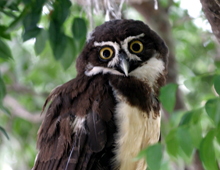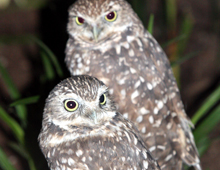
Found in forests from southern Mexico to Argentina, this owl was known to the Aztecs for sounding like “tiles clinking together”. Instead of hooting, they primarily produce a rapid knocking or tooting sound. Because of this call they are called “Coffin Makers” in parts of their range. Imported to England more than 150 years ago, it has long been a popular bird in captivity, and has bred in a number of collections, including the DWA. Young birds have a black mask that eventually retracts to the adult’s face pattern.





